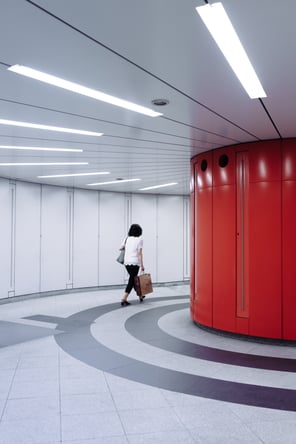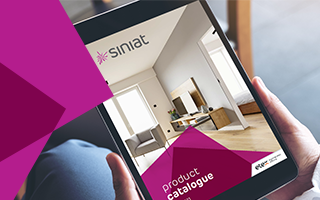Curved surfaces in interior spaces are making a comeback, but not all architects and builders are keen to incorporate curved surfaces because there is a perception that they can be costly and complicated to achieve. Is this a fair judgement?
Why do we love curves?
It has been scientifically proven that the human brain loves curves. In a 2013 neuroarchitectural study, it was found that participants were more likely to judge spaces as beautiful if they were curvilinear rather than rectilinear. (Neuroarchitecture is the field of study that examines how we connect to architecture on a physiological level.)
The most likely explanation for our love of all things curvaceous, is that they remind us of the beauty of nature.
Sydney architect Tony Owen told the Financial Review in a 2014 article that curves derive their inspiration from the efficiency of design in nature. “They also relate to the human body, the feminine form. It’s why iPhones, glasses and cars have curves; we instinctively love curvy things," he said. Curves also add a sense of movement to a structure.
Architects o ften opt for curvilinear designs to reflect the sense of fluidity of the natural exterior, e.g. the ocean or forest. Curves can also soften the impact of the building on the surroundings, and allow it to blend into the natural landscape.
ften opt for curvilinear designs to reflect the sense of fluidity of the natural exterior, e.g. the ocean or forest. Curves can also soften the impact of the building on the surroundings, and allow it to blend into the natural landscape.
Organic shapes set to become a trend
During the COVID pandemic people spent more time indoors, and it has led to significant changes in how we design the spaces we work and live in.
In a post-COVID 19 world, we can expect that there will be more emphasis on designing buildings that are not only functional and aesthetically pleasing, but also make us feel good.
In a recent article, Interior Design Trends That Will Shape the Next Decade, ArchDaily listed biophilic design, “chubby” design and arches as important influences on future interior design. These trends reflect our preference for organic shapes and contours in indoor spaces, and our instinct to connect with nature.
Biophilic design indoor living
At the heart of biophilic design is the hypothesis that humans possess an innate desire to seek connections with nature and other forms of life. It is believed that rekindling our connection with nature through design improves mental health and give creativity and production a boost.
The social distancing, lockdowns and remote working arrangements associated with Covid resulted in people spending less time outdoors. The built environment was essential in keeping us safe during this time, but humans lacked the natural connection with nature that they so instinctively crave. The continued isolation and confined lifestyle led to mental health issues that were well recorded during this time.
One of them was nature-deficit disorder, described by author and nature advocate Richard Louv as a phenomenon marked by challenges with focus, clear thinking, physical health and mental well-being.
It is safe to say that this disorder was not limited to the years of Covid isolation. It is generally recognised that Australians spend 90% or more of their time indoors.
One way to combat the effects of spending so much time indoors is to bring nature into the building, and this philosophy is at the heart of biophilic design. It is therefore not a surprise that biophilic design has become one of the latest design trends.
There are many ways to incorporate the biophilic design principle, including the use of natural materials, indoor gardens, water features and fresh air. Incorporating curvy and organic lines and shapes that remind us of nature is another important strategy.
Are curves hard to achieve?
Despite their beauty, architects and building designers are often wary of using curved walls and other surfaces. The perception is that it can be difficult to plan them into the design, challenging for the contractor and add to the costs.
Most building materials and elements are hard and inflexible and come standard with straight lines and dimensions. Successfully achieving curves with these materials requires skill and know-how.
In a 2015 article on the home renovation and design website Houzz, Architectural Curves: Are They Worth It?, Kate Fitzpatrick from Auhaus Architecture, known for using curves in many of their buildings, said number one piece of advice on curves is: “Proceed with caution.”
“They are hard to make work and if done badly they can look terribly clunky,” she said.
The extra cost, according to Fitzpatrick, is mainly from the additional labour, rather than the materials, with curves and angles more difficult to set up and construct.
But despite these obstacles, architects still love curves and many contractors are up for the challenge.
“If done well, they can be a fantastic sweeping gesture, enveloping space in a soft and organic way and moving you through spaces in a fluid manner,” Fitzpatrick said.
Curving plasterboard
Plasterboard provides an easier option to creating beautiful curves in internal spaces. With careful installation and proper framing methods, even tightly curved walls and ceilings can be achieved.
Most plasterboards can be curved to an extent. For curved finishes our plasterboard can be used in conjunction with Siniat Track Flexible - a complete solution for creating curved framing of walls, partitions, bulkheads, archways and columns.
Where really tight curves are required, we offer Siniat Curveshield. Curveshield is an internal wall and ceiling lining suitable for residential and commercial applications. It is 6.5 mm thick and perfect for applications where the radius is less than 900 mm and as small as 250 mm, although much tighter curves can be achieved in the hands of an experienced tradesperson.
When tight curves need to be achieved, we recommend using a template. Move it into the wall once the board has taken shape. Curve the board slowly, and remember that it is easier to curve plasterboard across the width (although this is counter intuitive).
Hot and humid conditions are ideal for curving plasterboard. In cold, low-humidity conditions or if very tight curves are required, prepare the plasterboard by applying a small amount of water to the plasterboard surface that will be in compression.
For more advice on curving plasterboard, download the Curveshield Product Data Sheet here.







